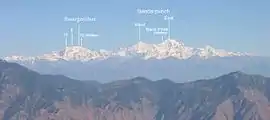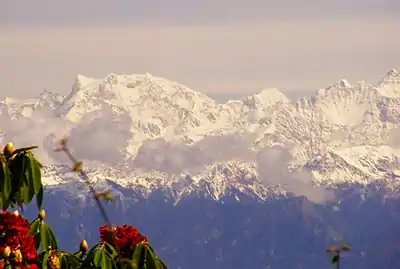Swargarohini
Swargarohini is a mountain massif in the Saraswati (Bandarpunch) Range of the Garhwal Himalaya. It lies in the Uttarkashi District of the northern Indian state of Uttarakhand, west of the Gangotri group of peaks. It comprises four separate peaks: Swargarohini I is the main peak, and is the subject of this article. While not particularly high by Himalayan standards, and not the highest in the Bandarpunch range, Swargarohini I is notable for its dramatic local relief. For example, its north face drops 2,000 metres (6,560 ft) in less than 2 kilometres (1.2 mi) of horizontal distance, and its south face achieves the same drop in less than 3 kilometres (1.9 mi). This makes it a steep and challenging climb. Swargarohini I has two summits, east and west. The east summit is given an elevation of 6,247 m (20,495 ft), slightly lower than the west summit. However the first ascensionists of the west summit claim that that summit is the higher of the two.[2]
| Swargarohini | |
|---|---|
 Swargarohini and Bandarpunch massifs | |
| Highest point | |
| Elevation | 6,252 m (20,512 ft) [1] |
| Coordinates | 31°05′04″N 78°30′58″E [1] |
| Geography | |
 Swargarohini | |
| Parent range | Garhwal Himalaya |
| Climbing | |
| First ascent | 1990 by a team from the Nehru Institute of Mountaineering |
| Easiest route | technical rock/snow/ice climb |
This snow-clad peak along is the source of the Tons River and along with the Bandarpunch massif it acts as a watershed between the Yamuna and the Bhagirathi Rivers.
Legends and history
Swargarohini derives its name from the legends associated with it from the hindu epic Mahabharata. In the final section of the epic, the Pandavas give up kingdom and travel northwards in the hope of reaching heaven. The peaks are said to be the stairway to heaven that was followed by Pandavas, but only Yudhishthira, the eldest of the Pandavas, is able to reach heaven. According to the legends it is believed that this is the only way one can go to heaven without dying. But the legends further gets complicated as many claim that the Pandavas had taken a route from the present town of Badrinath in the eastern part of Garhwal, Uttarakhand, which is very far apart from the Swargarohini peaks in Sankari range of western Garhwal. AHead of Badrinath, Mana and onwards to Satopanth Lake, one can see the Swargarohini Glacier ( no relation to Swargarohini peaks ) and Yudhishthira and the bow-bow ( form taken by Yamraj ) had climbed the Swargarohini glacier to the top and not the Swargarohini peak.
Climbing history
Swargarohini I have seen many climbing attempts. As of 1994, fifteen attempts had been made.[3] On 25 October 1974, Charles Clarke (England); Dilsher Singh Virk, Peter Fuhrman and Bruce MacKinnon (Canada); and Mohan Singh and Rattan Singh (India) made the first ascent of the west summit of Swargarohini I, ascending from the west side.[2]
The first ascent came on 3 May 1990, by a team of instructors from the Nehru Institute of Mountaineering. They climbed from the Ruinsara Valley on the north side, via the eastern col connecting the peak to the rest of the range, and found challenging rock climbing to achieve the col, leading to easier snow slopes above.[4] However, other sources claim that this ascent stopped (5 m (16 ft)) short of the summit due to the presence of an unstable cornice.[3]
The south face of the peak was attempted unsuccessfully in 1991.[5] On 7 June 1993, an expedition from Sweden made the first undisputed ascent of the peak via this face. The summit team comprised Birger Andrén, Ingela Nilsson, and Ake Nilsson. They ascended a rock ridge on the eastern side of the south face, leading to the easy east-southeast ridge.[3]
See also
- List of Himalayan peaks of Uttarakhand
References
- H. Adams Carter, "Classification of the Himalaya", American Alpine Journal, 1985, p. 141.
- Kamal K. Guha, "Swargarohini", American Alpine Journal, 1976, p. 527.
- Ake Nilsson, "Swargarohini", American Alpine Journal, 1994, p. 236.
- Harish Kapadia, "Swargarohini I", American Alpine Journal, 1991, pp. 255-256.
- Harish Kapadia, "Swargarohini I, South Face Attempt", American Alpine Journal, 1992, p.238.
